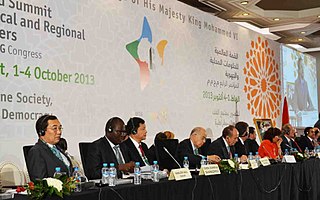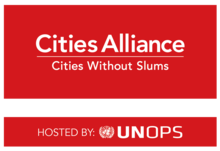
The United Nations Population Fund (UNFPA), formerly the United Nations Fund for Population Activities, is a UN agency aimed at improving reproductive and maternal health worldwide. Its work includes developing national healthcare strategies and protocols, increasing access to birth control, and leading campaigns against child marriage, gender-based violence, obstetric fistula, and female genital mutilation.

A slum is a highly populated urban residential area consisting of densely packed housing units of weak build quality and often associated with poverty. The infrastructure in slums is often deteriorated or incomplete, and they are primarily inhabited by impoverished people. Although slums are usually located in urban areas, in some countries they can be located in suburban areas where housing quality is low and living conditions are poor. While slums differ in size and other characteristics, most lack reliable sanitation services, supply of clean water, reliable electricity, law enforcement, and other basic services. Slum residences vary from shanty houses to professionally built dwellings which, because of poor-quality construction or lack of basic maintenance, have deteriorated.

The Department for International Development (DFID) was a ministerial department of the Government of the United Kingdom, from 1997 to 2020. It was responsible for administering foreign aid.
The United Nations Human Settlements Programme (UN-Habitat) is the United Nations programme for human settlements and sustainable urban development. It was established in 1977 as an outcome of the first United Nations Conference on Human Settlements and Sustainable Urban Development held in Vancouver, Canada, in 1976. UN-Habitat maintains its headquarters at the United Nations Office at Nairobi, Kenya. It is mandated by the United Nations General Assembly to promote socially and environmentally sustainable towns and cities with the goal of providing adequate shelter for all. It is a member of the United Nations Development Group. The mandate of UN-Habitat derives from the Habitat Agenda, adopted by the United Nations Conference on Human Settlements in Istanbul, Turkey, in 1996. The twin goals of the Habitat Agenda are adequate shelter for all and the development of sustainable human settlements in an urbanizing world.

The United Nations Office for Project Services (UNOPS) is a United Nations agency dedicated to implementing infrastructure and procurement projects for the United Nations System, international financial institutions, governments and other partners around the world. The organization's global headquarters is located at the UN City campus in Copenhagen, Denmark. UNOPS is in charge of disbursing more than $3 billion worth of development projects and contracts for its partners every year. Its activities have ranged from managing the construction of schools in Afghanistan, to building shelters in Haiti, to procuring ambulances to support the Ebola response in Liberia.
Slum upgrading is an integrated approach that aims to turn around downward trends in an area. These downward trends can be legal, physical (infrastructure), social or economic." The main objective of slum upgrading is to rehabilitate them into functional neighborhoods by addressing the social needs of the community, and improving integration into the formal urban economy.
Slum/Shack Dwellers International (SDI), is a global social movement of the urban poor that started in 1996. It forms a network of community-based organisations in more than 30 countries across Africa, Asia, Latin America and the Caribbean.

Sheela Patel is an activist and academic involved with people living in slums and shanty towns.
The United Nations Sustainable Development Group (UNSDG), previously the United Nations Development Group (UNDG), is a consortium of 36 United Nations funds, programmes, specialized agencies, departments and offices that play a role in development. It was created by the Secretary-General of the United Nations in order to improve the effectiveness of United Nations development activities at the country level.

United Cities and Local Governments (UCLG) is an umbrella international organisation for cities, local and regional governments, and municipal associations throughout the world that is concerned with representing and defending the interests of local governments on the world stage.

Culture 21, also known as Agenda 21 for culture, is a program for cultural governance developed in 2002–2004 and organized by United Cities and Local Governments.

The UN-Habitat Scroll of Honour Award was created by the United Nations Centre for Human Settlements (UNCHS) in 1989 to encourage and recognize the countries, governments, organizations, and individuals who have made great contributions to the development of housing. It is the most prestigious human settlements award in the world by the United Nations, given by the United Nations Human Settlements Programme (UN-Habitat), and has recognized 192 initiatives since its launch in 1989.

A secondary city is an urban hub that fills specific regional and local needs related to governance, economics, finance, education, trade, transportation. A secondary city is defined by population, area, function, and economic status, but also by their relationship to neighboring and distant cities and their socio-economic status. A secondary city may emerge from a cluster of smaller cities in a metropolitan region or may be the capital city of a province, state, or second-tier administrative unit within a country. Secondary cities are the fastest growing urban areas in lower and middle income countries, experiencing unplanned growth and development. By 2030, there will be twice as many medium size cities as there were in 1990, outnumbering the total number of megacities. According to the World Bank, secondary cities make up almost 40% of the world cities population. Many secondary cities in the Global South are expected to undergo massive expansions in the next few decades comparable to city growth in Europe and North America over the past two centuries. These cities are unique environments that generally have limited data and information on infrastructure, land tenure, and planning.
Slums are traditionally described as dense urban settlements, usually displaying characteristics such as crowded and compact housing units, informal delivery of utilities, and unofficial recognition by local government. In the Philippines, residents of slum areas are commonly referred to as "squatters" and have historically been subject to relocation or forced demolition. With a steadily growing metropolitan area, Metro Manila is subject to a densifying population of slum dwellers—a 2014 article states that Manila has an estimated 4 million people living in slums, out of a total population of 21.3 million.
Habitat III, the United Nations Conference on Housing and Sustainable Urban Development, took place in Quito, Ecuador, from 17 – 20 October 2016.

A Human Rights City is a municipality that engages with human rights. There are other definitions of human rights city available which are more specific and look at the human rights city from a particular angle. One says that a Human Rights City is a municipality that refers explicitly to the Universal Declaration of Human Rights and other international human rights standards and/or law in their policies, statements, and programs. Another definition states that a Human Rights City is 'a city which is organised around norms and principles of human rights'. This sociological definition emphasises the Human Rights City as a process to which to a varying degree a variety of agents contribute: from activists, experts and academics to international organisations, state governments, and local authorities and officials. Also, this definition does not qualify human rights as international, based on the fact that cities sometimes articulate human rights in their own charters in ways that have no formal or immediate recognition in international law, and may anticipate their appropriation by international bodies and incorporation into international law. The author claims that this definition captures better the different ways in which cities engage with human rights and participate in their co-production, not simply as receivers but also agents of human rights.

Even though mathematically more housing than needed is produced in Egypt resulting in millions of vacant homes, large portions of its residents live in inadequate housing that may lack secure tenure, safe drinking water and wastewater treatment, are crowded or are prone to collapse, as better housing is widely unaffordable. While there is also a problem with homelessness especially amongst children.

Sustainable Development Goal 11, titled "sustainable cities and communities", is one of 17 Sustainable Development Goals established by the United Nations General Assembly in 2015. The official mission of SDG 11 is to "Make cities inclusive, safe, resilient and sustainable". The 17 SDGs take into account that action in one area will affect outcomes in other areas as well, and that development must balance social, economic and environmental sustainability.

Joe Flood is a policy, data analyst and mathematician. He has made contributions to mathematics, housing and urban economics, urban indicators, slum studies, climate change and genetic genealogy.
Housing indicators are policy indicators designed to measure progress toward achieving housing policy goals. A housing indicator is a single, usually dimensionless number that points the way to improving housing outcomes. Because housing policy is heavily intertwined with other sectors such as social, economic, demographic and labour policy, and with the construction and finance industries, it requires a fairly comprehensive system of indicators to cover most of the key policies and issues. Housing indicator sets may contain political bias supporting the agendas or interests of those drawing up the system..













